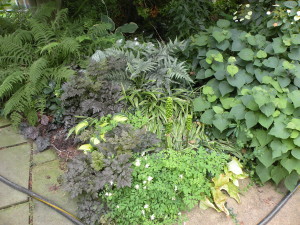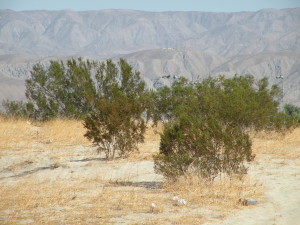Many people hear the word xeriscape and hear zeroscape, a word that does not exist. A xeriscape is a landscape designed with drought tolerant plants and minimal water. Although the desert is a xeriscape, such landscapes in Ohio need not look like deserts, in fact, should not, or they will look out of place. The key to successful implementation of a xeriscape is soil preparation that provides excellent drainage. Most drought tolerant plants need such drainage so that their roots do not rot in our moisture laden soils during winter and spring. In fact, I was quoted in the March issue of Lawn and Landscape on amending the soil with leaf humus and enlarged aggregate to ensure successful xeriscapes. The aggregate helps to break up the heavy clay in Ohio soils.

Dry shade perennials and ferns in my garden under a huge Magnolia ((Heuchera ‘Color Beauty’, Brunnera ‘Jack Frost’, Anthriscus sylvestris ‘Ravenswing’, Corydalis ochroleuca, Athyrium niponicum ‘Pictum’, Carex siderosticha ‘Variegata’, Hosta ‘Remember Me’, Arum italicum ‘Pictum’, Saruma henryii
Although xeriscape brings to mind an image of sun, drought tolerant landscapes can also be created for shady sites. I probably hear more complaints about dry shade than almost any other site. If you research any type of site, known as a habitat, you will find that there are plants that have accustomed themselves to such cultural strictures and thus do quite well.
For years, I tried to grow lavender but it usually gave up the ghost after a year or two. One year when I was in Provence, I walked into the lavender fields to examine the soil. You couldn’t even call it soil; it was broken stone. The light bulb went on. When I returned home, I added builder’s sand and pea gravel to the area for the lavender (this was before I knew about enlarged aggregate) and replanted. Since then, I have not had to take any lavender plants to the morgue.
In March 2008, I designed a xeriscape in a Cleveland Heights area where most homes have only minimal landscaping. The front faces east and is unobstructed; the back faces west and has good light in the morning and full sun in the afternoon. My client wanted me to transform a space that was stark, unusable, and a bit of an eyesore into a welcoming, colorful, ever-changing, usable landscape that would fill her with joy. The design was implemented in May/June 2008, and augmented with a design for naturalizing, deer resistant bulbs in Fall 2009. The client now loves to look out the windows, spend time on the patio, and welcome visitors.
Other requests included no irrigation, removal of all turf, a reconfigured front walk, a relaxation and grill area in back, utilization of as many existing site materials as possible, lots of color; ornamental grasses, and minimal maintenance. Impossible? No!
More about this design next week.






0 Comments